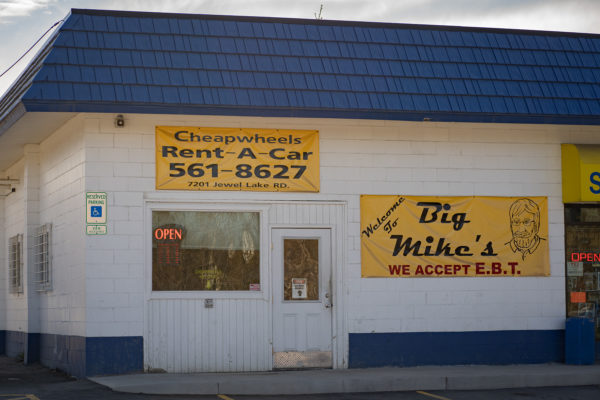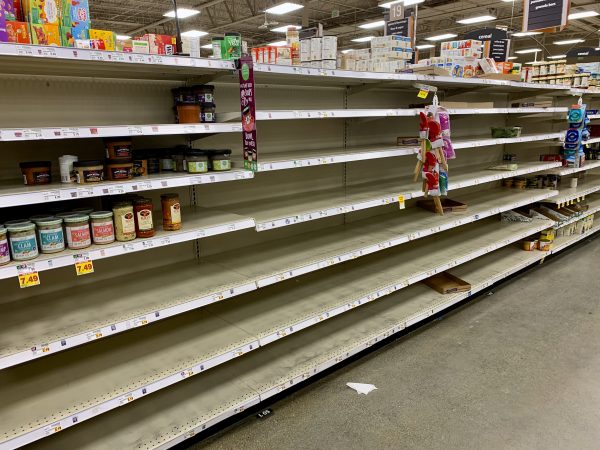
Alaska’s economy is crawling out of the coronavirus pandemic. And it looks a lot different now than it did 16 months ago.
There are thousands of vacant jobs. Home prices are surging. And, there are some serious supply shortages.
Alaska economist Neal Fried spoke with Alaska Public Media’s Tegan Hanlon last week about what’s low in stock and why.
Listen here:
An excerpt of the Neal Fried interview aired on Alaska News Nightly on Friday. Below is a transcript of the full conversation. It was edited for length and clarity.
[Sign up for Alaska Public Media’s daily newsletter to get our top stories delivered to your inbox.]
Hanlon: I’m curious, Neal, what can you tell us about where some of the worst supply shortages are in Alaska, and what’s behind them?
Fried: It’s hard to rank them. Some of its anecdotal, some of its actual, some of it has affected prices a lot. So, you know, it’s very real.
But let’s go back to toilet paper.

I know that’s an old story from early last year. When the pandemic began, everyone was buying toilet paper. They were panicked. The prices went up. We didn’t know when that shortage would come to an end. But it eventually did. It’s not a story anymore.
What’s interesting is: We thought that would be the end of the supply-chain problem. But, obviously, other shortages just keep on popping up. All kinds of things are happening.
And I think there’s a couple of reasons why.
One: We’ve had a lot of supply chain problems. Some of them are technology. The computer chips. Chips seem to be going into a lot of things. Even coffeemakers have chips in them, not just cars or computers, but just about everything. And just about everything that has a chip, a lot of that stuff is in short supply.
But also demand for a lot of things has either changed dramatically or increased dramatically. For a lot of different reasons, people’s tastes over this pandemic period have changed. We were going to the grocery store in the biggest way we ever have for a very, very long time, you know, seven or eight months ago. And now, we’re switching some of that consumption, for example, to restaurants and now a lot of restaurants are having a difficult time keeping up with that demand because the change occurred so quickly. And I think that’s happening with a lot of goods and services.

On top of this — that I think really sort of increased the shortages — is income. Now who would have thought during a recession, income would go up significantly?
Personal income increased by about 3% last year in the middle of a recession. And then that story is continuing. For the first quarter of this year, per capita personal income was at $72,000. And that compares to $62,000 in 2019, the first quarter, pre-pandemic. That’s $10,000 more on a per capita basis.
So that’s just illustrating that people have a lot more disposable income to spend, and they are spending a lot of it. So on top of tastes changing, people simply have more money to spend on what they’d like to spend money on.
Hanlon: So it seems like there’s a lot of factors that are at play right now: The coronavirus pandemic, jobs down, income up, the computer chip issue. Realizing maybe it’s hard to wrangle, but if you were to just summarize or list some of the shortages you’re hearing about, what would they be? What are what are some of the top things that come to mind?
Fried: Well, some of the top things are things that do have chips in them, whether they’re washing machines, whether they’re dryers, whether they’re convection ovens.
I know someone in the bakery business right now, and one of the things that’s slowing them down from opening up a new business, is they just can’t buy a new convection oven. Normally, you could have ordered it today and got it next week, or maybe even tomorrow. Now, you have to wait until maybe October or November or December.
My personal problem is I’m in the market for finding a used car. You know, I’m an economist, and we’re cheapskates. And I typically buy good used cars. Right now I have an old beater that has 200,000 miles on it and it’s not reliable. But, there’s a real shortage of used cars out there. You go into your favorite used car or any automobile parking lot, and you see fewer cars. There’s a lot less choice and prices have increased a lot.
The official inflation rates that came out just recently for April show that the average used car in the Anchorage area cost 25% more than it did just a year ago, in April. And that’s because typically when there’s a shortage and there’s a stronger than usual demand — that demand outstrips the supply in a huge way — prices respond. And, in this case, responded in a big way.
RELATED: A rental car shortage is forcing some travelers to reconsider their trips to Alaska
You’re seeing that with all kinds of things even, you know, firecrackers. They’re talking about shortages of chicken wings or chicken overall, and some other food products. I mean, some of those are also other supply chain problems we’ve had. Other weird things happen like big hurricanes. We’ve had, you know, the Suez Canal closed down for a while. There’s a shortage of truck drivers.
Hanlon: And, Neal, we talked a lot about what’s in short supply. But what do you envision for the long term for the supply of some of these goods? Like rental cars? Like bicycles?
Fried: I think that’s a really interesting question. And I think we did see very significant changes as people see this huge demand. And for all these goods and services, people are slowly filling in the gaps. I think a lot of people are getting in the market for some things that maybe they’ll eventually not even want anymore.
Let’s say you buy a bicycle today. You didn’t typically bike a lot, but you did more than usual the past year, because you had a lot of time. But then we go back to more normal times. I think a year from now, there might be a lot of goods out there that will be in large supply. And in some cases, businesses may be trying to get rid of this oversupply. Or even local consumers that have bought this stuff will be putting this stuff on Facebook or Craigslist or somewhere to sell.
If you can wait, there might be, I think, some really pretty good deals. That may be the bigger story next year: Do we have an oversupply of certain things?
Tegan Hanlon is the digital managing editor at Alaska Public Media. Reach her at thanlon@alaskapublic.org or 907-550-8447. Read more about Tegan here.





